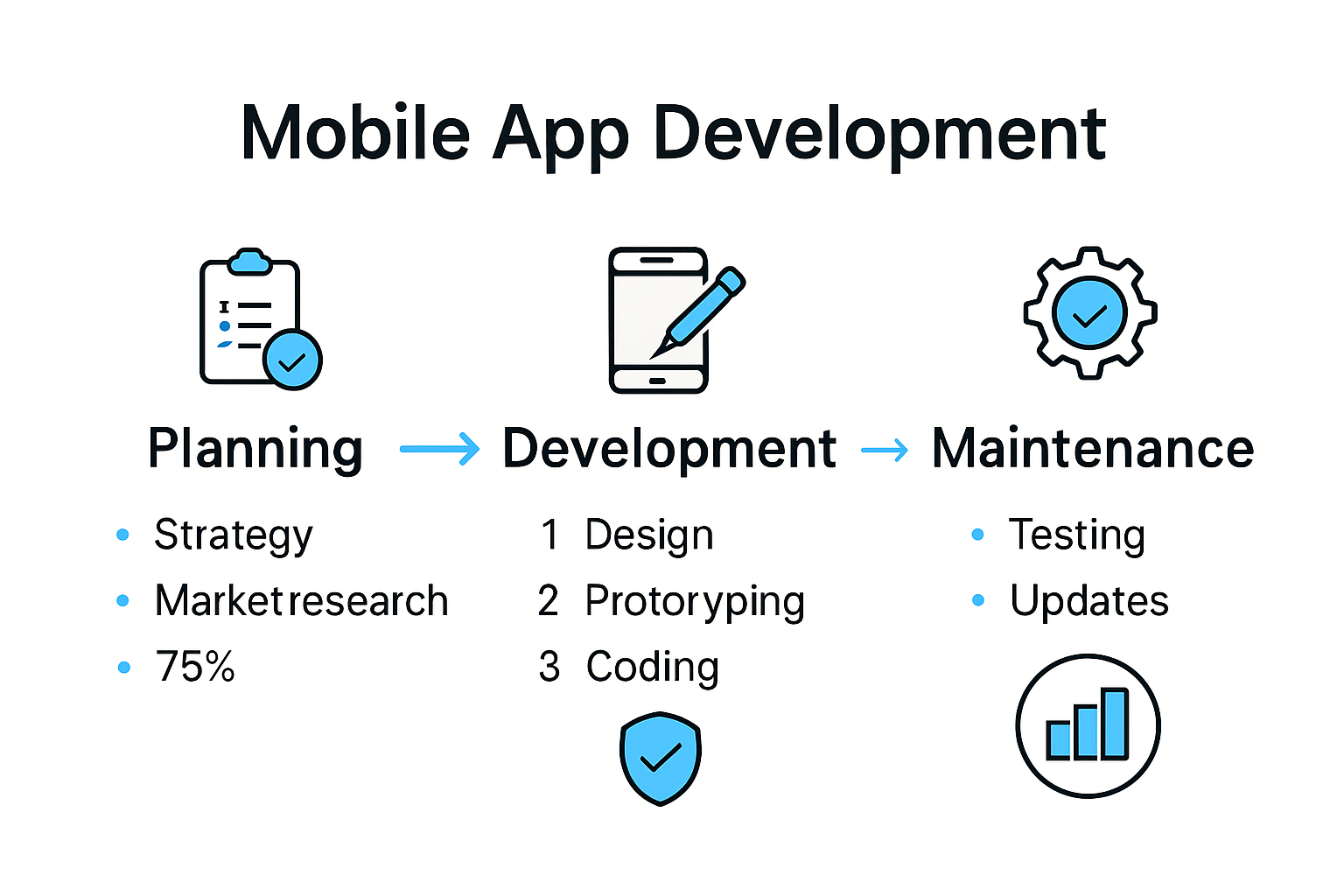Building a mobile app can turn a simple idea into a serious business boost and the stakes have never been higher for South African companies looking to stay competitive. You might think the hardest part is coding or coming up with a fancy design. However, research shows that businesses with clear mobile strategies are 60 percent more likely to see real digital transformation. Turns out, the real power sits in smart planning and strategic choices long before a single line of code gets written.
Table of Contents
- Planning Your Mobile App Strategy
- Choosing The Right App Development Approach
- Key Steps To Develop And Launch Your App
- Scaling, Securing And Maintaining Your Mobile App
Quick Summary
| Takeaway | Explanation |
|---|---|
| Define clear business objectives | Identify strategic goals your app should achieve to enhance success. |
| Choose the right development approach | Evaluate native versus hybrid methods based on performance and cost before starting. |
| Focus on user experience in design | Prioritize intuitive, engaging interfaces to meet user needs effectively. |
| Maintain ongoing app security and performance | Regular updates and protection measures are crucial for user trust and app integrity. |
| Adopt an agile development methodology | Use iterative processes for flexibility, allowing quick adjustments based on feedback. |
Planning Your Mobile App Strategy
Successful mobile app development begins with strategic planning that goes far beyond simply having a great idea. For South African businesses looking to build a mobile app, the planning phase determines the entire trajectory of your digital product.
Understanding Your Business Objectives
Before diving into technical specifications, clarify the precise strategic goals your mobile app will achieve. Are you aiming to enhance customer engagement, generate additional revenue streams, improve internal processes, or provide a unique service solution? Research from Deloitte suggests that businesses with clearly defined mobile strategies are 60% more likely to see successful digital transformation.
Consider these critical strategic considerations:
- Market Positioning: Identify how your app will differentiate from competitors in the South African market
- User Experience Goals: Define the specific user problems your app will solve
- Monetisation Strategy: Determine whether your app will generate direct revenue or support existing business models
Technical and Resource Planning
Mobile app development requires comprehensive resource allocation. You’ll need to evaluate technical requirements, budget constraints, and potential talent needs. Gartner’s Mobile App Development Research indicates that successful projects typically involve cross-functional teams with diverse skill sets.
Key planning elements include:
- Selecting appropriate development frameworks
- Estimating development timelines
- Budgeting for ongoing maintenance and updates
- Identifying required technical skills and potential recruitment needs
The strategic foundation you establish now will directly impact your mobile app’s long-term success. By taking a methodical approach to planning, you transform your digital initiative from a potential risk into a calculated business opportunity. Check out our comprehensive guide on mobile app development processes for more in-depth strategic insights.
Remember, a well-planned mobile app is not just a technological product—it’s a strategic business asset designed to drive growth, enhance customer experiences, and create competitive advantages in an increasingly digital marketplace.
Choosing the Right App Development Approach
Selecting the appropriate mobile app development approach is a critical decision that will significantly impact your project’s success, timeline, and overall performance. Different methodologies offer unique advantages, and understanding these can help South African businesses make informed choices.
Native vs Hybrid Development Strategies
When considering how to build a mobile app, businesses typically choose between native and hybrid development approaches. Research from the International Mobile App Development Survey reveals that hybrid methodologies are gaining traction due to their flexibility and cost-effectiveness.
Native development involves creating separate applications for iOS and Android platforms using platform-specific programming languages. This approach offers:
To help you quickly weigh up the pros and cons of Native vs Hybrid app development approaches discussed above, here’s a comparison table highlighting their key features and benefits:
| Feature | Native Development | Hybrid Development |
|---|---|---|
| Performance | High (optimised for each platform) | Moderate (runs on a shared codebase) |
| Access to Device Features | Full access; better integration | Limited; uses plugins for access |
| User Interface | Platform-specific, more refined | More generic, consistent across devices |
| Development Cost | Higher (separate code for each) | Lower (single codebase) |
| Time to Market | Longer (two teams needed) | Faster (simultaneous deployment) |
| Maintenance | More effort per platform | Easier (update once for all platforms) |
- Performance Optimisation: Direct access to device features and smoother user experiences
- Advanced Functionality: Better integration with device-specific capabilities
- High-End User Interface: More refined and platform-specific design elements
Hybrid development, conversely, allows developers to create a single codebase that works across multiple platforms. This method provides:
- Cost Efficiency: Reduced development time and lower overall expenses
- Faster Market Entry: Quicker deployment across different platforms
- Easier Maintenance: Simpler updates and consistent functionality
Agile Development Methodology
A comprehensive industry survey highlights the growing preference for agile methodologies in mobile app development. Agile approaches emphasise iterative development, continuous feedback, and adaptive planning.
Key benefits of agile development include:
- Rapid prototyping and testing
- Enhanced collaboration between development teams
- Flexibility to adapt to changing business requirements
- Continuous improvement through incremental development
For South African businesses seeking a comprehensive understanding of modern development processes, our detailed guide on mobile app development strategies offers deeper insights into selecting the right approach.
Ultimately, the choice depends on your specific business needs, budget constraints, technical requirements, and long-term digital strategy. Carefully evaluate each approach’s strengths and limitations to ensure your mobile app development journey aligns perfectly with your organisational goals.
Key Steps to Develop and Launch Your App
Transforming your mobile app from a conceptual idea into a functional digital product requires a systematic and strategic approach. Understanding the essential development stages will help South African businesses navigate the complex journey of mobile app creation.
Inception and Design Planning
According to Coursera’s mobile app development framework, the initial phase involves critical market research and precise value identification. This stage is about refining your app concept and establishing a clear vision.
Key activities during inception include:
- Market Analysis: Research potential user needs and competitive landscape
- User Persona Development: Create detailed profiles of your target audience
- Feature Prioritisation: Identify core functionalities that deliver maximum value
The design phase focuses on creating an intuitive and engaging user interface. Research from the Queensland Government emphasises the importance of co-designing applications with end-users to ensure sufficient uptake and return on investment.
Development and Prototyping
Once design specifications are finalised, the development process begins. This stage involves transforming design concepts into functional code, creating a working prototype that can be tested and refined.
Critical development considerations include:
- Selecting appropriate programming languages and frameworks
- Implementing robust backend infrastructure
- Ensuring cross-platform compatibility
- Building scalable and secure architectural foundations
For a comprehensive understanding of our mobile app development processes, we recommend exploring our detailed guide that provides deeper insights into technical implementation strategies.
Testing, Deployment, and Continuous Improvement
The final stages involve rigorous testing, platform deployment, and establishing mechanisms for ongoing refinement. This phase is crucial for identifying and resolving potential issues before public release.
Key activities include:
- Comprehensive functional and usability testing
- Performance optimization
- Security vulnerability assessment
- User acceptance testing
- Platform submission and approval processes
Successful mobile app development is an iterative journey. By maintaining a user-centric approach and remaining adaptable to feedback, businesses can create digital solutions that genuinely solve problems and deliver exceptional user experiences.
Scaling, Securing and Maintaining Your Mobile App
Developing a mobile app is not a one-time event but an ongoing process of evolution, protection, and optimization. South African businesses must adopt a strategic approach to ensure their mobile applications remain robust, secure, and capable of meeting changing user demands.

Implementing Robust Security Measures
Research from the Hong Kong Government’s InfoSec guidelines emphasizes the critical importance of integrating security measures throughout the entire development lifecycle. Mobile app security is not an afterthought but a fundamental requirement for protecting user data and maintaining trust.
Key security strategies include:
Here is a summary checklist to guide your mobile app security planning, covering the primary measures highlighted in the security section:
| Security Measure | Description |
|---|---|
| Data Encryption | Protect sensitive information with encryption |
| Regular Security Audits | Schedule frequent vulnerability assessments |
| Secure Authentication | Implement multi-factor or advanced authentication |
| Compliance Management | Align practices with data protection regulations |
| Secure Coding | Use static analysis and best coding practices |
- Data Encryption: Implement strong encryption protocols for sensitive user information
- Regular Security Audits: Conduct comprehensive vulnerability assessments
- Secure Authentication: Develop multi-factor authentication mechanisms
- Compliance Management: Ensure alignment with data protection regulations
The Software Engineering Institute at Carnegie Mellon University recommends using static analysis tools and adhering to secure coding practices to minimize potential security vulnerabilities.
Scalability and Performance Optimization
Successful mobile apps must be designed to handle growing user bases and increasing computational demands. A systematic mapping study highlights the need for comprehensive reliability strategies that extend beyond traditional testing approaches.
Scalability considerations include:
- Implementing cloud-based infrastructure
- Designing efficient database architectures
- Creating modular code structures
- Using load balancing techniques
- Developing adaptive caching mechanisms
For a comprehensive understanding of our mobile app development strategies, explore our detailed guide on maintaining digital solutions.
Continuous Maintenance and User Experience Enhancement
Maintaining a mobile app requires ongoing commitment. Regular updates, performance monitoring, and user feedback integration are crucial for long-term success. Businesses must develop a systematic approach to:
- Monitor app performance metrics
- Address user-reported issues promptly
- Introduce new features based on market trends
- Ensure compatibility with latest operating system versions
- Optimize app size and resource consumption
Successful mobile app maintenance is not just about fixing problems but proactively creating exceptional user experiences. By treating your mobile app as a living, evolving product, you can ensure its continued relevance and value in an increasingly competitive digital landscape.

Frequently Asked Questions
What are the key steps to build a mobile app for business success?
The key steps include strategic planning, understanding business objectives, choosing the right development approach (native or hybrid), design planning, development and prototyping, testing and deployment, and ongoing maintenance.
How do I decide between native and hybrid app development?
Choosing between native and hybrid development depends on your business needs. Native apps offer better performance and user experience but require more resources and time. Hybrid apps are cost-effective and quicker to market but may have some limitations in accessing device features.
Why is agile development methodology beneficial for mobile app development?
Agile development allows for iterative development, enabling continuous feedback and adaptability to changing requirements. This methodology promotes collaboration and faster testing, which can significantly enhance the app’s quality and responsiveness to user needs.
What measures can I take to ensure my mobile app remains secure?
To ensure app security, implement data encryption, conduct regular security audits, use secure authentication methods, and comply with data protection regulations. Integrating security throughout the app development lifecycle is essential to protect user data and maintain trust.
Transform Your Mobile App Vision into Real Business Results
Are you facing uncertainty about how to turn your mobile app strategy into a valuable digital asset for your company? Many South African businesses struggle with bridging the gap between a great idea and a successful launch. You may worry about technical complexities, choosing the right development approach, or ensuring ongoing security and growth. If any of this feels familiar, you are not alone. By following the structured planning, agile processes, and strategic maintenance mentioned in our article, you are already on the right path.
Take the next confident step and let experienced digital experts help you avoid common pitfalls. Visit our web design and development quotation page for tailored guidance and transparent costing. If you want a custom solution that is scalable, secure, and fully integrated with your brand’s needs, get started with Cloudfusion today. Let us help you turn your mobile app concept into a powerful business success story.
Recommended
- Mobile App Development Process for Businesses in 2025
- Blog Author: Cloudfusion by Cloudfusion
- Website Development by Cloudfusion
- What Is Web Development? Essential Guide for Businesses 2025
- Odoo Mobile Applications | Odoo mobile CRM -Bista Solutions
- Mobile Conversion Optimization Strategies for 2025: Boost Sales Fast








